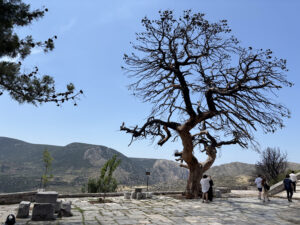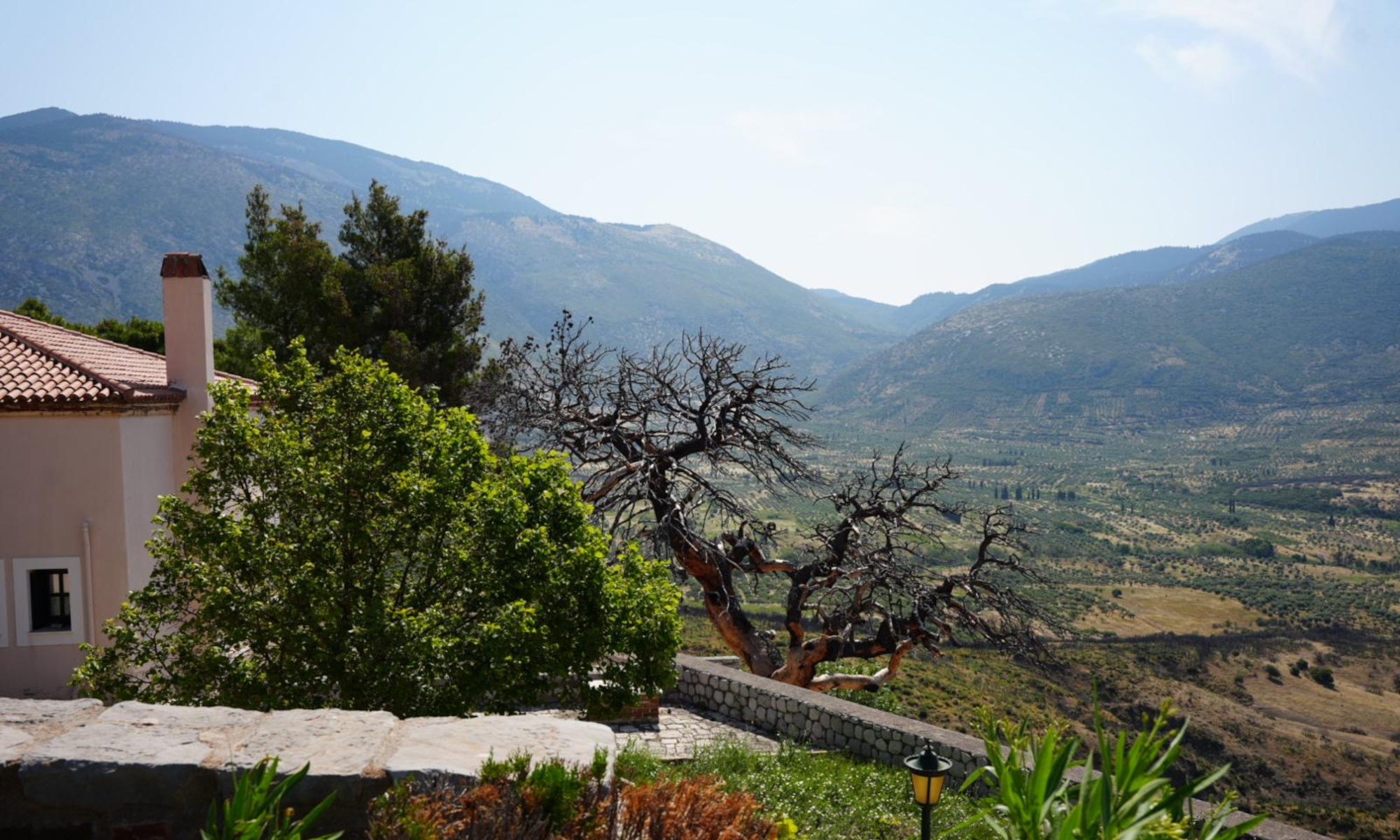Hosios Loukas, a tenth-century Orthodox monastery, is just down the road from Delphi. Are they linked by more than proximity?
By Noah LaBelle

Father Anthimos left home at the age of twenty and spent fifteen years without seeing his mother. If that’s what devotion to the Almighty demanded, it was fine by him.
“Mount Athos is a peninsula, and it is not allowed for women,” he said, describing the Eastern Orthodox monastic community where he’d spent nearly all of his adult life. Twenty monasteries. Some two-thousand monks. “I liked it very much there, because I did not have my mother,” he quipped.
Now, he’s at Hosios Loukas, a tenth-century monastery tucked into the olive-covered foothills of Mount Helicon. It’s just over a half-hour’s drive from Delphi, another site of ancient sanctity.
At first glance, the two—Delphi and Hosios Loukas—seem at odds. One, in ruins, is stone-strewn. Its temple, treasuries, stadium, and amphitheatre are now divided among reconstructed fragments, displays in the adjacent museum, and still-buried remains. The other, intact in an elegant mélange of brick, stone, and marble, beams with golden mosaics, as revered today as they were in Byzantium.
Then there’s the tension between God and the gods. “Phoibos [Apollo] no longer has his house, nor his mantic bay, nor his prophetic spring; the water has dried up,” the Pythia lamented in 362 A.D., in one of the final Delphic auguries. Gone were the days when Chaerephon, a friend of Socrates, and Alexander the Great schlepped up to the vapor-dazed oracle. Predictions ceased.
That is, until Luke of Steiris, a Hellenic hermit, came along half a millennium later. With his mother’s blessing, a fourteen-year-old Luke left to live as an ascetic on a mountain called Ioannitza. A life of Christ-centered divinity—over Apollonian divination—ensued, and with it, prophecy. In his teens, Luke foretold the Bulgarian invasion of Ioannitza. He also predicted Emperor Romanos’ conquest of Crete: fulfilled in the 960s, a decade after Luke’s death in 953. By then, he’d already settled down, founded Hosios Loukas, and, as tradition holds, got caught levitating during prayer.
The gods had gone silent on Mount Parnassus. Luke’s monastery still prays. God, it appears, never left central Greece.
***
I met Anthimos in the courtyard, apron pale against his black habit and kalimavkion. Together, they mirrored the charred conifer abutting the entry walkway. In August 2023, a wildfire swept the valley, and a pine cone-turned-grenade torched one of the oldest buildings to a crisp. Anthimos arrived this March.
Inside the octagonal katholikon—christened the finest surviving church interior from the first centuries after Iconoclasm—his phone rang. He let it. First, he scrubbed the icons a visitor had just kissed, post-signum crucis. Mary. Loukas. I watched, pondering the contents of the spray bottle. Windex? Certainly not. (Later, I consulted The Byzantine Forum, an online hub for all things Eastern Christian, which suggested a mix of waters: rose and holy. But, as one commenter warned, “Rosewater doesn’t remove lipstick.”)
“I never imagined that one day someone would call me to go outside of Mount Athos,” Anthimos told me.
Then the Archbishop called. “‘I have this monastery,’” Anthimos recalls him saying. “‘There are three monks. Can you help me?’”
Only the Archbishop himself knows if it was the wildfire that prompted Anthimos’ move, or the lopsided ratio of fathers to foreigners. Perhaps both.
Still, it beats Mount Athos. There, the monks rose at two o’clock sharp. After devotion: hours toiling on trees. “Here, we start at seven,” Anthimos said, smiling.
I wasn’t sure whether his chats with visitors, myself included—“from Australia, from Canada, from Hong Kong,” he said—counted toward his eight hours of work or his eight hours of rest. Prayer, I surmised, was separate. Then again, sharing the monastery might be a kind of devotion in itself.
What was clear: this wasn’t the Delphi crowd. The day before, to my chagrin, a woman in a safety vest—just a stone’s throw away—screamed into a whistle when she spotted a pack of kids trying to hop the stadium wall. Delphi sees close to a million visitors a year. For Hosios Loukas, there’s no public figure. Enough to keep Anthimos busy, and make him want to stay.
“But, I’m open in everything in my life,” Anthimos said, once certain he’d die at Mount Athos.
At Delphi, there was a phrase for that: kairòn gnôthi—know the right moment. Stobaeus found it etched near the Temple of Apollo, and recorded it in his fifth-century anthology of Delphic maxims. This was just years after Theodosius, the Roman Emperor, had outlawed the old gods, cementing the empire’s shift to Christianity.
That alone didn’t shutter the oracle. It took a natural disaster: an earthquake in 381 A.D. sealed the fissures releasing ethylene, a sweet-smelling gas that induces euphoria, and with them, the vapor trances that powered the Pythia and their prophecies.
One more rogue pine cone, and Hosios Loukas might’ve gone the way of Delphi. ♦
